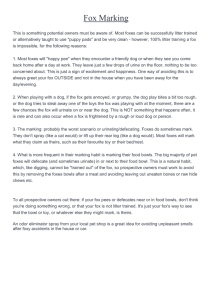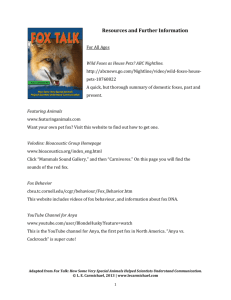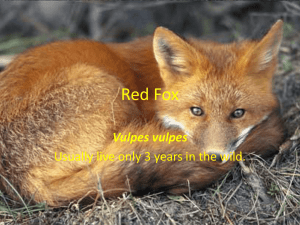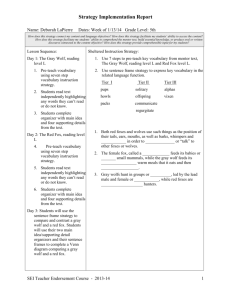fox fact sheet - World Animal Foundation
advertisement
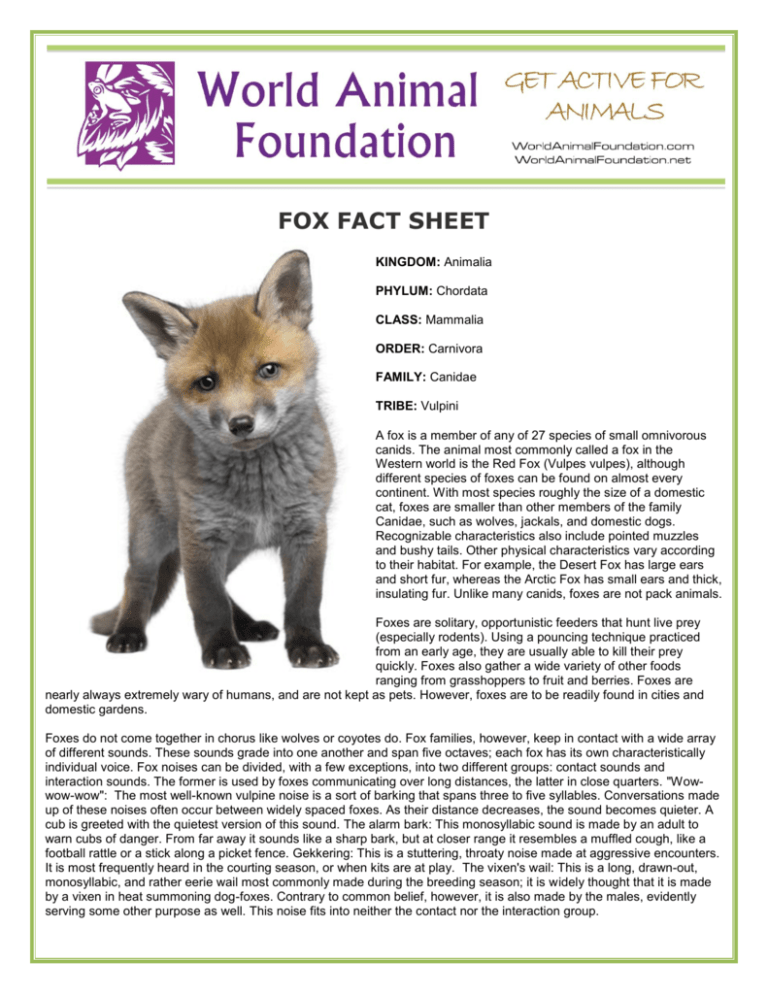
FOX FACT SHEET KINGDOM: Animalia PHYLUM: Chordata CLASS: Mammalia ORDER: Carnivora FAMILY: Canidae TRIBE: Vulpini A fox is a member of any of 27 species of small omnivorous canids. The animal most commonly called a fox in the Western world is the Red Fox (Vulpes vulpes), although different species of foxes can be found on almost every continent. With most species roughly the size of a domestic cat, foxes are smaller than other members of the family Canidae, such as wolves, jackals, and domestic dogs. Recognizable characteristics also include pointed muzzles and bushy tails. Other physical characteristics vary according to their habitat. For example, the Desert Fox has large ears and short fur, whereas the Arctic Fox has small ears and thick, insulating fur. Unlike many canids, foxes are not pack animals. Foxes are solitary, opportunistic feeders that hunt live prey (especially rodents). Using a pouncing technique practiced from an early age, they are usually able to kill their prey quickly. Foxes also gather a wide variety of other foods ranging from grasshoppers to fruit and berries. Foxes are nearly always extremely wary of humans, and are not kept as pets. However, foxes are to be readily found in cities and domestic gardens. Foxes do not come together in chorus like wolves or coyotes do. Fox families, however, keep in contact with a wide array of different sounds. These sounds grade into one another and span five octaves; each fox has its own characteristically individual voice. Fox noises can be divided, with a few exceptions, into two different groups: contact sounds and interaction sounds. The former is used by foxes communicating over long distances, the latter in close quarters. "Wowwow-wow": The most well-known vulpine noise is a sort of barking that spans three to five syllables. Conversations made up of these noises often occur between widely spaced foxes. As their distance decreases, the sound becomes quieter. A cub is greeted with the quietest version of this sound. The alarm bark: This monosyllabic sound is made by an adult to warn cubs of danger. From far away it sounds like a sharp bark, but at closer range it resembles a muffled cough, like a football rattle or a stick along a picket fence. Gekkering: This is a stuttering, throaty noise made at aggressive encounters. It is most frequently heard in the courting season, or when kits are at play. The vixen's wail: This is a long, drawn-out, monosyllabic, and rather eerie wail most commonly made during the breeding season; it is widely thought that it is made by a vixen in heat summoning dog-foxes. Contrary to common belief, however, it is also made by the males, evidently serving some other purpose as well. This noise fits into neither the contact nor the interaction group. ARCTIC FOX FACT SHEET KINGDOM: Animalia PHYLUM: Chordata CLASS: Mammalia ORDER: Carnivora FAMILY: Canidae GENUS: Vulpes SPECIES: V. lagopus The Arctic Fox is a small fox native to cold Arctic regions of the Northern Hemisphere. It is common to see an arctic fox in all three tundra biomes. Artic foxes have smaller, more rounded ears, a more rounded braincase, and a slightly shorter and broader muzzle than the red fox. The Arctic Fox lives in some of the most frigid extremes on the planet. Arctic Foxes eat a wide variety of things, including lemmings, Arctic Hare, birds and their eggs and carrion. The most important of these foods is lemming. A family of foxes can eat dozens of lemmings each day. During April and May, Arctic Foxes also prey on Ringed Seal pups when the young animals are confined to a snow den and are relatively helpless. Sometimes they follow polar bears and eat the leftover prey. When their normal prey is scarce, Arctic Foxes scavenge the leftovers of larger predators, such as Polar Bears, even though Polar Bears' prey includes the Arctic Fox itself. The foxes tend to form monogamous pairs in the breeding season. Litters of about half a dozen to a dozen whelps are born in the early summer, a very large litter size for mammals. The parents raise the young in a large den. Arctic foxes' habitats are tundra and coastal areas. The white morph is generally associated with true tundra habitat, the blue more with coastal habitat. Arctic Foxes have a circumpolar range, meaning that they are found throughout the entire Arctic, including Russia, Canada, Nunavut, Alaska, Greenland and Svalbard, as well as in sub-Arctic and alpine areas, such as Iceland and mainland alpine Scandinavia. The conservation status of the species is good, except for the Scandinavian mainland population. It is acutely endangered, despite decades of legal protection from hunting and persecution. The total population estimate in Norway, Sweden and Finland is a mere 120 adult individuals. The abundance of Arctic Foxes tends to fluctuate in a cycle along with the population of lemmings. Because the foxes reproduce very quickly and often die young, population levels are not seriously impacted by the inhumane practice of trapping. They have, nonetheless, been eradicated from many areas where humans are settled. FENNEC FOX FACT SHEET KINGDOM: Animalia PHYLUM: Chordata CLASS: Mammalia ORDER: Carnivora FAMILY: Canidae GENUS: Vulpes SPECIES: V. zerda The Fennec is a small fox found in the Sahara Desert of North Africa (excluding the coast) which has distinctive oversized ears. The Fennec is the smallest canid. The animals are often a sandy color to blend in with their desert surroundings. Its ears, which are the largest in the canid family, serve to help dissipate heat. The coat can repel sunlight during the day and conserve heat at night. The soles of the feet are protected from the hot sand by thick fur. The Fennec is nocturnal. During the night, it will hunt for rodents, insects (such as locusts), lizards, and birds and eggs. It also eats a small lizard known as a sandfish. The Fennec gets most of its water from food, but will sometimes eat berries and leaves as an additional source of water. Fennecs live in large dens, often with several foxes. The basic social unit is thought to be a mated pair and their offspring, and the young of the previous year are believed to remain in the family even after a new litter is born. Playing behavior is common, including among adults of the species. They engage in highly social behavior, typically resting while in contact with each other. They mate for life, with each pair or family controlling their own territory. Sexual maturity is reached at around nine months old. The species usually breeds only once each year. The copulation tie has been recorded as lasting up to two hours and 45 minutes. Following mating, the male becomes very aggressive and protective of the female, providing her with food during her pregnancy and lactation periods. Gestation is usually between 50 to 52 days. The typical litter is between one and four kits, with weaning taking place at around 61 to 70 days. When born, the kit's ears are folded over and its eyes are closed, with the eyes opening at around ten days and the ears lifting soon afterwards. The life span of a Fennec Fox has been recorded as up to 12 years in captivity, but only up to 10 in the wild. The fennec is rare and is not often seen. It is often hunted by humans, even though the fox does not cause any harm to human interests. GRAY FOX FACT SHEET KINGDOM: Animalia PHYLUM: Chordata CLASS: Mammalia ORDER: Carnivora FAMILY: Canidae GENUS: Urocyon SPECIES: U. cinereoargenteus The Gray Fox (Urocyon cinereoargenteus) is a species of fox ranging from southern Canada, throughout most of the lower United States and Central America, to Venezuela. This species, and the closely related Island Fox, are the only living members of the genus Urocyon, which is considered to be among the most primitive of the living canids. The gray fox has a gray back, tawny sides, neck and legs, a white belly, and a black stripe along its back and tail. Another black stripe crosses its face from the nose to the eye and continuing to the side of the head. Standing about 12-16 inches at the shoulders, weighing up to 16 pounds, and having an overall body length of up to 47 inches, the gray fox is an agile canid able to scurry up and down trees with relative ease. The gray fox's ability to climb trees is shared only with the Asian raccoon dog among canids. Its strong, hooked claws allow it to scramble up trees to escape many predators such as the domestic dog or the coyote, or to reach tree-bound or arboreal food sources. It descends primarily by jumping from branch to branch, or by descending slowly backwards as a house cat would do. The gray fox is nocturnal or crepuscular and dens in hollow trees, stumps or appropriated burrows during the day. The gray fox is a solitary hunter and is largely omnivorous. It frequently preys upon the Eastern Cottontail, though it will readily catch voles, shrews, and birds. The gray fox supplements its diet with whatever fruits are readily available and generally eats more vegetable matter than does the Red Fox. The gray fox is monogamous. The breeding season of the gray fox varies geographically; in Michigan, the gray fox mates in early March, in Alabama, breeding peaks occur in February. The gestation period lasts approximately 53 days. Litter size ranges from 1 to 7. Kits begin to hunt with their parents at the age of 3 months. By the time they are 4 months old, the kits will have developed their permanent dentition and can now easily forage on their own. The family group still remains together until autumn when the young reach sexual maturity and then disperse. RED FOX FACT SHEET KINGDOM: Animalia PHYLUM: Chordata CLASS: Mammalia ORDER: Carnivora FAMILY: Canidae TRIBE: Vulpini GENUS: Vulpes SPECIES: V. vulpes The Red Fox (Vulpes vulpes) is the largest of the true foxes, as well as being the most geographically spread member of the Carnivora, being distributed across the entire northern hemisphere from the Arctic Circle to North Africa, Central America, and the steppes of Asia. Its range has increased alongside human expansion, having been introduced to Australia, where it is considered harmful to native mammal and bird populations. Because of these factors, it is listed as Least Concern for extinction by the IUCN. Forty-five subspecies are currently recognized, which are divided into two categories: the large northern foxes, and the small, primitive southern foxes of Asia and the Middle East. Red foxes are social animals, whose groups are led by a mated pair which monopolizes breeding. Subordinates within a group are typically the young of the mated pair, who remain with their parents to assist in caring for new kits. The species primarily feeds on small rodents, though it may also target leporids, game birds, reptiles, invertebrates and young ungulates. Fruit and vegetable matter is also eaten on occasion. Although the red fox tends to displace or even kill its smaller cousins, it is nonetheless vulnerable to attack from larger predators such as wolves, coyotes, golden jackals and medium and large felines. The species has a long history of association with humans, having been extensively hunted as a pest and furbearer for centuries, as well as being prominently represented in human folklore and mythology. Because of its widespread distribution and large population, the red fox is one of the most important furbearing animals harvested for the inhumane fur trade. Red foxes use their urine to mark their territories. Urine is also used to mark empty cache sites, as reminders not to waste time investigating them. Red foxes live in family group sharing a joint territory or a pack, scout or troop made of an alpha male and/or female with rogues (loner or abandoned foxes) and family members. In favorable habitats and/or areas with low hunting pressure, subordinate foxes may be present in a range. Subordinate foxes may number 1-2, sometimes up to 8 in one territory. These subordinates could be formerly dominant animals, but are mostly young from the previous year, who act as helpers in rearing the breeding vixen's kits. Non-breeding vixens will guard, play, groom, provision and retrieve kits. Red foxes may leave their families once they reach adulthood if the chances of winning a territory of their own are high. If not, they will stay with their parents, at the cost of postponing their own reproduction. Red fox body language consists of movements of the ears, tail and postures, with their body markings emphasizing certain gestures. Postures can be divided into aggressive/dominant and fearful/submissive categories. Some postures may blend the two together. Red foxes have a wide vocal range, and produce different sounds spanning five octaves, which grade into each other.

